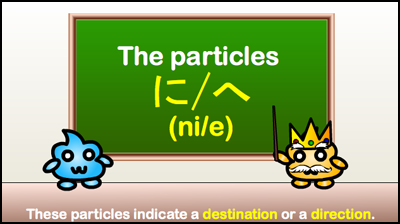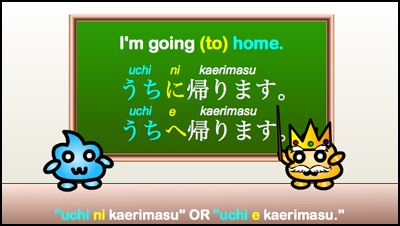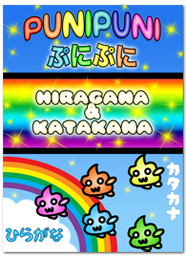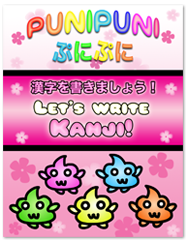☆ PuniPuni Youtube ☆
Japanese Grammar Lesson 12: Destination Particles に (ni) and へ (e) – Review Notes
Today we learned how to use the Japanese particles に (ni) and へ (e) to indicate destination or direction. In this review, we will go over what we learned in the video, and we will talk about some other uses of these particles.
………………………………………………………………………………..
Using the particle に (ni) or へ (e) as “to”:

★ The Japanese particles に (ni) and へ (e) can be used to indicate destination or direction. They are translated as to in English.
★ When used in this way, に (ni) and へ (e) are interchangeable.
 ★ In this example, に (ni) and へ (e) are translated as to.
★ In this example, に (ni) and へ (e) are translated as to.
They are indicating a destination and direction, and therefore either can be used.

★ In this example, に (ni) and へ (e) do not directly translate as to because we do not say I’m going to home in English, we just say I’m going home. However, they are indicating a destination and direction all the same, so we do need to use either に (ni) or へ (e) in this sentence.
…………………………………………………………………………………
About the particle へ (e):
★ The Japanese particle へ is written using the hiragana which is pronounced he in other words, but it is pronounced e as a particle.
★ The Japanese particle へ is often used to welcome somebody to someplace. In these kinds of sentences, へ is preferred over に.
日本へようこそ。
Nihon e yōkoso.
Welcome to Japan.
…………………………………………………………………………………
About the Particle に (ni):
★ The Japanese particle に has many, many uses. It probably has the most uses out of all the Japanese particles. However, many of them are very easy to pick up on. In all of these other uses except the one we showed in the video, に can no longer be replaced with へ.
…………………………………………………………………………………
Indirect Object Marker に (ni):
The particle に marks the indirect object in the sentence. The indirect object is the person or thing that receives the direct object in the sentence. For example:
彼は私にペンをくれました。
Kare wa watashi ni pen o kuremashita.
He gave me a pen./He gave the pen to me.
So, in this example, 私 (watashi) is the indirect object, the one who is receiving the direct object (the pen). If you saw our video about the particle を (o) you should know that pen is the direct object of this sentence.
★ The Indirect object usually comes before the direct object in a sentence.
…………………………………………………………………………………
Indicating a source or agent using に (ni):
★ に indicates source or agent in passive or causative verbs. It translates as by in English.
田中さんに日本語を教えてもらいました。
Tanaka san ni nihongo o oshietemoraimashita.
I was taught Japanese by Mr./Ms. Tanaka.
…………………………………………………………………………………
The use of に (ni) with frequency expressions:
★ The particle に is used with frequency expressions such as per week, per day, etc.
………………………………………………………………………………..
Example 1:
一日に二時間ぐらい勉強します。
Ichinichi ni nijikan gurai benkyō shimasu.
I study about 2 hours per day.
…………………………………………………………………………………
Indicating a specific point in time using に (ni):
★ The particle に is used with various time expressions (year, month, day, and clock time) to indicate a specific point in time. It translates as at, on, or in. However, expressions of relative time, such as today or tomorrow, don’t take the particle に. To learn more in-depth about this use, click here!
………………………………………………………………………………..
Example 1:
七時に起きます。
Shichiji ni okimasu.
I wake up at 7:00.
………………………………………………………………………………..
Example 2:
日曜日に友達と勉強しました。
Nichiyōbi ni tomodachi to benkyō shimashita.
I studied with a friend on Sunday.
…………………………………………………………………………………
Indicating purpose using に (ni):
★ The particle に is used to indicate purpose. It translates as to or in order to. To learn more in-depth about this use, click here!
………………………………………………………………………………..
Example 1:
映画を見に行きました。
Eiga o mi ni ikimashita.
I went to see a movie.
………………………………………………………………………………..
Example 2:
勉強しに来ました。
Benkyō shi ni kimashita.
I came to study.
…………………………………………………………………………………
Indicating direction of action using に (ni):
★ The particle に is used when a motion or action is directed at or onto an object or place.
………………………………………………………………………………..
Example 1:
ここに名前を書いて下さい。
Koko ni namae o kaite kudasai.
Please write your name here.
………………………………………………………………………………..
Example 2:
ノートをかばんに入れました。
nōto o kaban ni iremashita.
I put the notebook in the bag.
…………………………………………………………………………………
Indicating location of existence using に (ni):
★ The particle に is typically used with verbs such as iru (to exist [for living things]), aru (to exist [for non-living things]) and sumu (to live [somewhere]). It translates into at or in.
………………………………………………………………………………..
Example 1:
机の上に本があります。
Tsukue no ue ni hon ga arimasu.
There is a book on the desk.
………………………………………………………………………………..
Example 2:
あそこに猫がいました。
Asoko ni neko ga imashita.
There was a cat over there.
………………………………………………………………………………..
Example 3:
東京に住んでいます。
Tōkyō ni sundeimasu.
I live in Tokyo.
………………………………………………………………………………..
Conclusion:
Today we learned about the Japanese particles に and へ. We learned that they can both be used to indicate destination or direction. We also learned a lot of other ways to use the particle に. If you have any questions, leave a comment below (◕ω◕)♪
………………………………………………………………………………..
Do you want a Japanese tutor?
Take Japanese Skype Lessons with Professional Japanese Teachers on kakehashijapan.com!
………………………………………………………………………………..
………………………………………………………………………………..













9 comments
I’d like a small clarification about one of the uses of に please! When you use the particle to indicate purpose, is it always followed by the noun form of a verb? I know that in this context, “し” is a form of する and that 見 is a form of 見る, and I just wanted to know if this was a pattern to follow when using the particle に in this way.
ありがとうございます! ^w^
Comment by Chip on 11/13/2012 at 8:26 pmWhen using ni to indicate purpose, the purpose may be a noun indicating an activity, such as 買い物 (shopping) or コンサート (concert), or it may be a verbal expression such as テニスをします (play tennis) or ご飯を食べます (eat dinner/food).
In the case of nouns, you don’t need to change anything but with verbal expressions, you just take the stem of the verb (the part that comes before ます).
食べます –> 食べ
します –> し
So for example:
買い物に行きます (kaimono ni ikimasu) – I go shopping
ご飯を食べにいきます (gohan o tabe ni ikimasu) – I go out to eat.
Hope that helps (◕ω◕)♪
Comment by PuniPuni on 11/14/2012 at 10:40 amI’m a bit confused on example no. 2 for using ni to indicate the location of existence because the “neko” word is not in there, and the sentence starts out with “benkyo shi.” Or is the “benkyo shi” word also spoken as “asoko?” o:
Comment by Joy on 11/20/2012 at 11:44 pmGomen! I just forgot to change that part when I copied and pasted the sentence from above there to keep the format. I fixed it so it should be correct now. Sorry about that (>ω<;) Thanks for pointing it out!
Comment by PuniPuni on 11/21/2012 at 12:22 amHi PuniPuni!!!!
Comment by JapanTokyoLover on 11/06/2013 at 11:45 amThanks for this clear lesson but i have a question.
If i want to say: Over there on the table there’s a book
I have to put the particle に twice?
I mean…the question should be so
あそこに机の上に本があります
As you see…the particle needs to be used twice ?
Tell me if there’s any correction,i’d like to know where i’m mistaking,if i’m mistaking (*^ω^*)
ありがとう (*≧∇≦*)
Although you translated it literally, the Japanese doesn’t sound natural. It is better to say あのテーブルの上に本があります。- There is a book on that table (over there). You can use the word あの plus a noun to say “that ___ (over there).” Hope that helps (◕ω◕)♥
Comment by PuniPuni on 11/07/2013 at 2:47 amdear sensei,
please correct me if i’m wrong.
1. I made a sentence using the particle ‘ni’ to indicate ‘location of existence’
Under the bed, there is a boy hiding
beddo no shita ni ototonoko kakushite iru.
2. the other thing is in your example ‘indicating a source or agent’ where:
Tanaka san ni nihongo o oshietemoraimashita.
I was taught Japanese by Mr./Mrs. Tanaka.
I learned that the -masu verb for teach is oshiemasu. and the -te form is oshiemashite.
can you explain why the past tense of oshiemas is oshietemoraimashita and not simply oshiemashimashita.
is it because oshietemoraimashita means taught ‘by’ therefore it is different?
please explain sensei.
3. how about if i change the sentence slightly, using ‘indirect object marker’ plus the ‘frequency expression.’
Ichinichi ni Tanaka san wa watashi ni nihongo o oshiemashimashita.
Everyday Mr./Mrs. Tanaka taught Japanese to me.
did i get that right? please correct my mistakes sensei.
Comment by heritz on 04/12/2014 at 6:01 pmthank you sensei.
1. Your use of “ni” is fine in this sentence, but there are some other mistakes. “Boy” in Japanese is “otokonoko.” After “otokonoko” you need to put the subject marker “ga.” So it should be like this: “beddo no shita ni otokonoko ga kakushite iru.” (A boy is hiding under the bed).
2. This is kind of difficult grammar, but oshietemoraimashita is actually a combination verb. The dictionary form of this verb is “oshieru.” The te-form is “oshiete.” After the te-form of this verb, another verb comes to make a combination. This second verb in dictionary form is “morau.” In polite-past form it is “moraimashita.” This verb is used when you have someone do something for you. So, the combination of these two verbs roughly translates to “I had him teach me…” But when used in a sentence like this it is not translated like that. This is advanced grammar, so please don’t worry about it too much now.
3. “Ichinichi ni” does not mean “every day.” You would not use the particle “ni” with “every day” (mainichi). This frequency expression means how many times in a certain amount of time. So, in the example we gave “Ichinichi ni nijikan gurai benkyō shimasu” this means “I study about 2 hours per day.” It is this “(time) ni (time)” that is the frequency expression. If you want to say “Everyday Mr./Mrs. Tanaka taught Japanese to me” you should say “mainichi tanaka san ga watashi ni nihongo o oshietekuremashita.” This “oshietekuremashita” is another combination verb, but once again it is very advanced grammar. We will do a video explaining these combination verbs someday.
Comment by PuniPuni on 04/12/2014 at 8:49 pmThanks Sensei for the thorough explanation.
Comment by heritz on 04/13/2014 at 8:30 amFor now I’ll stick to the basic and study the whole video again. I don’t think I’m ready for the advance grammar as yet. (@_@)